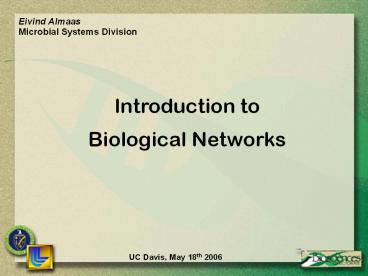Introduction to - PowerPoint PPT Presentation
Title:
Introduction to
Description:
Eivind Almaas Microbial Systems Division Introduction to Biological Networks The core is highly essential: 75% lethal (only 20% in non-core) for E. coli ... – PowerPoint PPT presentation
Number of Views:151
Avg rating:3.0/5.0
Title: Introduction to
1
Eivind Almaas Microbial Systems Division
Introduction to Biological Networks
2
Biological network examples
- Gene-regulation
- Protein interaction
- Metabolism
- Cell signaling
- Cytoskeleton
- Neural network
- Lymphatic node system
- Circulatory system
3
Cellular networks
GENOME
4
(No Transcript)
5
(No Transcript)
6
(No Transcript)
7
Protein interactions Yeast two-hybrid method
8
P. Uetz et. al. Nature 403, 601 (2000) H. Jeong
et. al. Nature 411, 41 (2001)
9
(No Transcript)
10
PINs are scale-free
- Protein interaction networks are scale-free.
- is this because of preferential attachment?
- another mechanism?
- how can we determine the cause?
11
Comparison of proteins through evolution
Use Protein-Protein BLAST (Basic Local Alignment
Search Tool) -check each yeast protein against
whole organism dataset -identify significant
matches (if any)
12
Preferential Attachment!
For given ?t ?k ? ?(k)
k vs. ?k linear increase in the of links
13
SF topology from duplication diversification
Wagner (2001) Vazquez et al. 2003 Sole et al.
2001 Rzhetsky Gomez (2001) Qian et al.
(2001) Bhan et al. (2002).
14
(No Transcript)
15
Network motifs
- Definition A motif is a recurrent network
module - Examples
- Can think of networks as constructed by
combining these - basic building blocks
- Do these motifs have special properties?
16
PIN motifs and evolution
Protein BLAST against A. thaliana C.
elegans D. melanogaster M. musculus H.
sapiens
S. Wuchty, Z.N. Oltvai, A.-L.Barabasi, 2003.
17
Network peeling
- Core decomposition method
- the k-core consists of all nodes with degree gt
k. - recursively remove nodes with degree lt k.
S. Wuchty and E. Almaas, Proteomics 5, 444
(2005).
18
Local vs. global centrality
S. Wuchty and E. Almaas, Proteomics 5, 444
(2005).
19
Properties of globally central proteins
S. Wuchty and E. Almaas, Proteomics 5, 444
(2005).
20
(No Transcript)
21
(No Transcript)
22
Metabolic Networks
Nodes chemicals (substrates) Links chem.
reaction
H. Jeong, B. Tombor, R. Albert, Z.N. Oltvai, and
A.L. Barabasi, Nature 407, 651 (2000).
23
Scaling of clustering coefficient C(k)
The metabolism forms a hierarchical network!
(why?)
Ravasz, et al, Science 297, 1551 (2002).
24
Hierarchical Networks
Remember definition of clustering In
hierarchical networks, hubs act as connectors
between modules! Why could this be beneficial?
Ravasz, et al, Science 297, 1551 (2002).
25
(No Transcript)
26
How can we simulate metabolic function?
Constraints Optimization for growth
J.S. Edwards B.O. Palsson, Proc. Natl. Acad.
Sci. USA 97, 5528 (2000) R.U. Ibarra, J.S.
Edwards B.O. Palsson, Nature 420, 186 (2002) D.
Segre, D. Vitkup G.M. Church, Proc. Natl. Acad.
Sci. USA 99, 15112 (2002)
27
Simple example
Reaction network
1 2 6
3 4 5 7
- We need
- List of metabolic reactions
- Reaction stoichiometry
- Assume mass balance
- Assume steady state
Edwards, J. S. Palsson, B. O, PNAS 97, 5528
(2000). Edwards, J. S., Ibarra, R. U. Palsson,
B. O. Nat Biotechnol 19, 125 (2001). Ibarra, R.
U., Edwards, J. S. Palsson, B. O. Nature 420,
186 (2002).
28
Optimal fluxes in E. coli
29
(No Transcript)
30
A. Barrat, M. Barthélemy, R. Pastor-Satorras, and
A. Vespignani, PNAS 101, 3747 (2004) P.J.
Macdonald, E. Almaas and A.-L. Barabasi, Europhys
Lett 72, 308 (2005)
31
Single metabolite use patterns
Evaluate single metabolite use pattern by
calculating
Two possible scenarios (a) All fluxes approx
equal (b) One flux dominates
32
Functional plasticity of metabolism
33
Functional plasticity of metabolism
- There exists a group of reactions NOT subject to
structural - plasticity the metabolic core
- These reactions must play a key role in
maintaining the metabolisms - overall functional integrity
34
Essential metabolic core
- The core is highly essential 75 lethal (only
20 in non-core) for E. coli. -
84 lethal (16 non-core) for S. cerevisiae. - The core is highly evolutionary conserved
- 72 of core enzymes (48 of
non-core) for E. coli.
E. Almaas, Z. N. Oltvai, A.-L. Barabási, PLoS
Comput. Biol. 1(7)e68 (2005)
35
Metabolic core flux variations synchronized
E. Almaas, Z. N. Oltvai, A.-L. Barabási, PLoS
Comput. Biol. 1(7)e68 (2005)
36
Summary
- Cellular networks are predominantly scale-free
- Network structure constrains dynamics
- Protein interaction network from preferential
attachment - Networks motifs and k-core decomposition
- Metabolic fluxes are scale-free
- Metabolic fluxes correlate with the network
topology - Fluxes predominantly flow along metabolic
super-highways - Synchronized essential metabolic core

